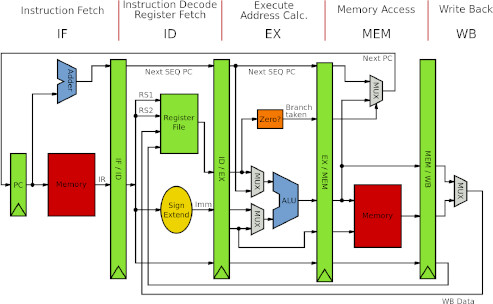The best way to understand how a processor works in detail is to create one from scratch or, in my case, write a software simulation of one. This was one of our assignments for our Computer Architecture course, and required us to to implement a Mips I processor, as it was not too complex, but did implement the fundemental ideas of a processor and how it operates.
* Quick introduction to processors
** What is a processor?
A processor is a digital circuit that receives instructions and exectues them sequentially. These instructions can be anything from branching instructions, that go to a different location in the code, to arithmetic instructions that can add two numbers together. Instructions are normally stored in memory and are produced by a higher level language such as C or C++ using a compiler. However, other languages exist as well, such as python, that run using an interpreter, which compiles the files on the fly and runs them. The image above shows a possible basic setup for a processor, which in this case is the Mips I processor.

Figure 1: Mips processor layout.
A processor also has to be able to store information to be able to execute these instructions. Normally, processors have a small number of registers that are suited for this purpose. This number varies between architectures such as Arm, Mips and intel, but in this case the Mips processor has 32 registers. These registers are 32 bit wide, which means they can store an integer or an address to a location in memory, which can then be used to load data from.
** Types of Processors
There are two main types of processor architectures, RISC and CISC processors. RISC processors are designed around the principle that the actual circuit should be as simple as possible, which means that the instructions have to be fairly simple too. The advantage of this is that the circuit and the actual processor gets simpler to build and optimise, however, it also means that the compiler that will eventually turn a program into instructions, will have to be clever about optimisations it makes, so as to minimise the amount of instructions. Examples of a RISC processor is an Arm process or a MIPS processor.
In contrast to this, a CISC processor is much more complex when looking at the architecture and has many more instructions than a RISC processor, that will often do multiple things at once. The advantage of this is that the compiler does not have to be as clever anymore, as there are many instructions that correspond directly with something that a programmer wants to do in the code, however, it means that the complexity of the hardware increases by a lot.